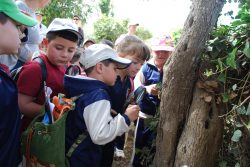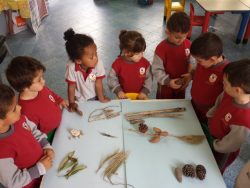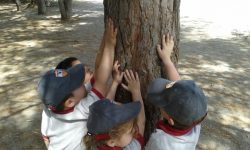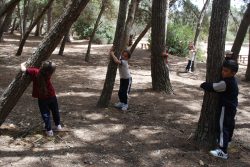Using the outdoors to teach young children across the curriculum is ideal: they like to draw, to count and to explore colours and shapes. Therefore it is easy to engage them to be active, to use their senses and to learn through direct experiences. At the same time, outdoor learning helps children to develop their creativity, confidence, social and cognitive skills, and it teaches them about the natural environment. Despite the health and learning benefits, outdoor learning is not embedded in the formal school education in Malta.
The Nature Days Activity Guide and teacher training
At BirdLife Malta we are striving to connect children with nature so they can enjoy its benefits while they learn to appreciate and care for the environment. It’s recognised that starting early in life is important to foster such care.
With that in mind, BirdLife Malta created a guidebook called ‘Nature Days Activity Guide’ to help teachers of early years (Year 1, 2 and Kinder) to teach students outdoors, away from the familiar school classroom. Every teacher who received the guidebook participated in a training, where BirdLife Malta demonstrated how to use the guidebook and how to run the described outdoor activities. Or as one teacher put it: “It was an activity that showed us how we can use nature to teach our children different subjects and to love and take care of our surroundings”. The trainings, in which a total of 210 teachers participated, took place either at schools or at Buskett Woodland.
How teachers use the guide after the training is up to them: they can repeat the described activities as they are, they can adapt them so they suit their teaching plan, budget and location, or they are welcome to use it as an inspiration to invent their own outdoor learning ideas.
The survey
We were interested in if and how teachers used the Nature Days Activity Guide after the training, therefore we asked them to participate in a short online survey. The survey was conducted in June and July 2016 through Survey Monkey. We received feedback from 20 teachers: 13 of them already used the resource book since the training and most of them plan to use it in the following scholastic year. Some of the teachers who haven’t used the guide yet mentioned that they were already busy the last scholastic year but are planning to fit in the next year.
After running activities from the guide book the teachers reported:
- The guide book being age appropriate
- The guide book being helpful to run activities
- The guide book inspired them to design their own activities.
- Students enjoy learning outdoors
- Students engage better outside, use all their senses and interact with each other.
“We think that the guide book is great and is suitable for quite a wide range of age groups. For us it was the first time that Kindergarten students were involved and that was great and satisfactory and most educational for them especially since we were well informed and could expand in awareness.”
“They are very interesting and motivate the students to observe the nature around them and help them concentrate on tasks given.”
“Children really enjoyed the activities and they learned to observe more the nature around them. These activities helped them use all their senses.”
“Students liked the activities a lot.”
“The Nature Days Activity Guide is a very informative booklet with lots of ideas for practical activities outside in the nature.”
“The kids enjoyed hugging a tree and name it after themselves or their pets. They also loved finding real life insects and watching them.”
“Children really enjoyed these activities and learned a lot as well.”
Half of the teachers have already developed the activities further and got inspired to spend more time outdoors, for example in the school yard. They took pupils out on nature walks and set up math trails to count bird calls, the number of fallen leaves etc. Others used nature to teach kids about emotions: they made sad and funny faces out of materials found in Buskett woodland. Using the outdoors to help kids de-stress and be more mindful seemed to be popular: several teachers practiced yoga, meditation and other relaxation techniques with the children, like sitting quietly and listening to birds.
BirdLife Malta rewards the teachers who use the guide with Dinja Waħda points. Teachers seemed to be interested in earning these points as they already reported back to us or planning to do so soon. Some teachers also trained their colleagues who have not taken part in the trainings by BirdLife Malta and passed on the guide.
Time constraint as a major impediment to outdoor learning
“I wish l could squeeze in more!”
“At school we were packed with other activities this scholastic year, so we could not fit in the activity guide. Will be using the activity guide next scholastic year.”
“I just have to find time as we are loaded with what we have to do during the school year.”
Many teachers complained that they are too busy delivering the curriculum but will try to squeeze in Nature Days activities next year. It seems that there is an interest to do more outdoor activities but lack of time limits the teachers to go outside.
We would like to stress the point that outdoor learning shouldn’t be considered as something that takes time away from learning. Linking outdoor activities to learning outcomes would allow it to become part of a curriculum so there would be no need to find extra time to go outside. It has been shown that children learn better outside, especially those who have troubles focusing inside the classroom. Beside the learning opportunity, being outdoors provide health benefits to both students and teachers, so teachers who teach outdoors receive positive benefits beside professional development.
Acknowledgements
We would like to thank the teachers who took the effort and participated in our survey.
We are very happy to receive positive feedbacks from teachers and that the guide book inspire them to spend more time in nature. We hope that time will not be a limitation and that these outdoor activities won’t be isolated episodes but become embedded in the curriculum.
The guidebook, which can also inspire family outings besides teaching, is available for download from this link. If you are a teacher and interested in earning Dinja Waħda points, don’t forget to get in touch with us!
By Dóra B. Huszár, Education Assistant at BirdLife Malta





